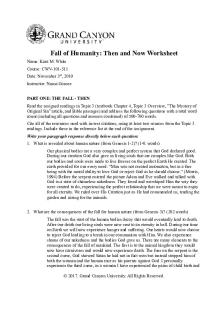Chapter 1 Mirror For Humanity PDF

| Title | Chapter 1 Mirror For Humanity |
|---|---|
| Course | Exploring Culture and Gender through Film |
| Institution | University of Colorado Boulder |
| Pages | 2 |
| File Size | 71.1 KB |
| File Type | |
| Total Downloads | 51 |
| Total Views | 135 |
Summary
Chapter One notes ...
Description
Mirror For Humanity Notes Chapter 1 “What is Anthropology?” The Cross-Cultural Perspective - Anthropology offers a cross-cultural perspective - Anthropologists study non-industrial peoples, AND all societies, ancient and modern, simple and complex - Constantly compare one society’s customs to another - Ethnography: personal study of local settings - Including field work for a few years studying customs and people Human Adaptability - “Creativity, adaptability and flexibility are basic human attributes” (p. 2) - Culture is not biological, it is learned, but depends on biology Definitions Anthropology: The study of humans around the world and through time Holism: The study of the whole of the human condition, past present and future, biology society, language and culture Society: Organized life in groups Cultures: traditions and customs, transmitted through learning that form and guide the beliefs and behavior of the people exposed to them Enculturation: How children learn the culture, by growing up in it Adaptation: The processes by which organisms cope with environmental forces and stresses (like terrain or climate) - People who lived at high altitudes (Himalayas in Tibet or Nepal) acquired genetic advantages to live at high altitudes Cultural Forces Shape Human Biology Biocultural: using and combining both biological and cultural perspectives and approaches to analyze and understand a particular issue or problem - Cultural traditions push certain activities (in America, girls figure skate or do gymnastics or dance) and set standards for beauty, shown in events like the Olympics where America and Canada do better at individual sports rather than somewhere like Brazil - Brazil doesn’t have many female swimmers because of the bulky, manly body it builds from years of swimming, as there the ideal body type is extremely feminine with large hips. General Anthropology Definition: The academic discipline of anthropology, or the “four-field” anthropology - Four Fields - Sociocultural Anthropology / Cultural Anthropology - Anthropological Archaeology - Biological Anthropology - Linguistic Anthropology - Early Anthropologists mainly were concerned with the native peoples of North America The Subdisciplines of Anthropology - Cultural Anthropology - The study of human society and culture
-
Social and cultural similarities and differences Two ways to study this - Ethnography - Based on fieldwork - Gather data to analyse and develop an account of that culture (for a book or film etc) - Linkages with other cultures are important - Ethnology - Studies the results of ethnography - Compare and generalize - Anthropological Archaeology (or just Archaeology) - Finds patterns, theories and generalizations from material remains - Tools, weapons, campsites - This helps find out about history and groups and how they lived their life (hunted, cooked, had families, friends or a complete society) - Excavation - Digging through a succession of layers of ground at a site - Biological Anthropology - The study of human biological diversity through time and as it exists today - Five Specialities - Human biological evolution revealed by the fossil record - Human genetics - Human growth and development - Human biological plasticity (body’s abilities to adapt and change with environmental changes or different conditions, like heat, cold, or altitude) - Primatology (study of monkeys or apes) - Some genetics are better for reproducing - Linguistic Anthropology - We don’t know when humans could first speak - Studying language in its social and cultural context throughout the world and over time. - Sociolinguistics: investigates relationships between social and linguistic variation - Variation could be caused by geography with its dialects and accents Applied Anthropology - “Concerned with the relationships between anthropological knowledge and uses of that knowledge in the world beyond anthropology” (Erve Chambers) - Cultural Resource Management preserves sites but also destroys if they are not significant...
Similar Free PDFs

Chapter 1 Mirror For Humanity
- 2 Pages

Chapter 1 The Study of Humanity
- 7 Pages

CWV101-T3Fall Of Humanity
- 5 Pages

Clc fall of humanity
- 1 Pages

Chapter 1 for mechanics
- 40 Pages

Solution for Chapter 1
- 95 Pages

Humanity essay Stasiland
- 3 Pages

Nature of Humanity Essay
- 7 Pages

Mirror Drawing Experiment
- 4 Pages

Mns - mirror neuron system
- 3 Pages

Circle Mirror Transformation 2
- 3 Pages

EL DEFINITIVO SMART MIRROR
- 87 Pages

Black Mirror: Nosedive review
- 1 Pages

Black Mirror nosedive
- 1 Pages
Popular Institutions
- Tinajero National High School - Annex
- Politeknik Caltex Riau
- Yokohama City University
- SGT University
- University of Al-Qadisiyah
- Divine Word College of Vigan
- Techniek College Rotterdam
- Universidade de Santiago
- Universiti Teknologi MARA Cawangan Johor Kampus Pasir Gudang
- Poltekkes Kemenkes Yogyakarta
- Baguio City National High School
- Colegio san marcos
- preparatoria uno
- Centro de Bachillerato Tecnológico Industrial y de Servicios No. 107
- Dalian Maritime University
- Quang Trung Secondary School
- Colegio Tecnológico en Informática
- Corporación Regional de Educación Superior
- Grupo CEDVA
- Dar Al Uloom University
- Centro de Estudios Preuniversitarios de la Universidad Nacional de Ingeniería
- 上智大学
- Aakash International School, Nuna Majara
- San Felipe Neri Catholic School
- Kang Chiao International School - New Taipei City
- Misamis Occidental National High School
- Institución Educativa Escuela Normal Juan Ladrilleros
- Kolehiyo ng Pantukan
- Batanes State College
- Instituto Continental
- Sekolah Menengah Kejuruan Kesehatan Kaltara (Tarakan)
- Colegio de La Inmaculada Concepcion - Cebu

